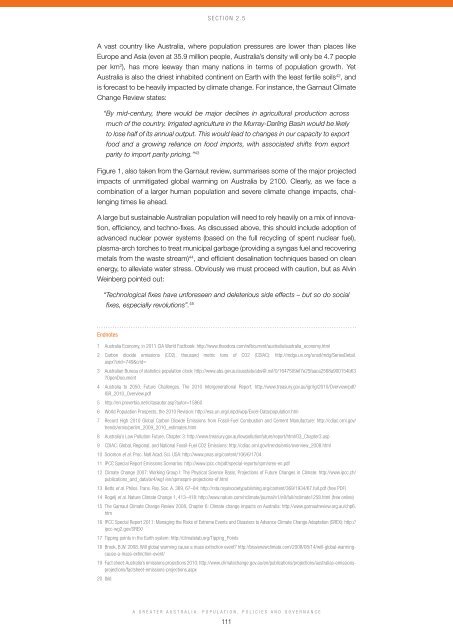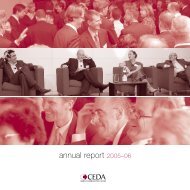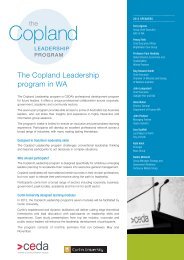Section 2.5A vast country like <strong>Australia</strong>, where population pressures are lower than places likeEurope <strong>and</strong> Asia (even at 35.9 million people, <strong>Australia</strong>’s density will only be 4.7 peopleper km 2 ), has more leeway than many nations in terms of population growth. Yet<strong>Australia</strong> is also the driest inhabited continent on Earth with the least fertile soils 42 , <strong>and</strong>is forecast to be heavily impacted by climate change. For instance, the Garnaut ClimateChange Review states:“By mid-century, there would be major declines in agricultural production acrossmuch of the country. Irrigated agriculture in the Murray-Darling Basin would be likelyto lose half of its annual output. This would lead to changes in our capacity to exportfood <strong>and</strong> a growing reliance on food imports, with associated shifts from exportparity to import parity pricing.” 43Figure 1, also taken from the Garnaut review, summarises some of the major projectedimpacts of unmitigated global warming on <strong>Australia</strong> by 2100. Clearly, as we face acombination of a larger human population <strong>and</strong> severe climate change impacts, challengingtimes lie ahead.A large but sustainable <strong>Australia</strong>n population will need to rely heavily on a mix of innovation,efficiency, <strong>and</strong> techno-fixes. As discussed above, this should include adoption ofadvanced nuclear power systems (based on the full recycling of spent nuclear fuel),plasma-arch torches to treat municipal garbage (providing a syngas fuel <strong>and</strong> recoveringmetals from the waste stream) 44 , <strong>and</strong> efficient desalination techniques based on cleanenergy, to alleviate water stress. Obviously we must proceed with caution, but as AlvinWeinberg pointed out:“Technological fixes have unforeseen <strong>and</strong> deleterious side effects – but so do socialfixes, especially revolutions”. 45Endnotes1 <strong>Australia</strong> Economy, in 2011 CIA World Factbook: http://www.theodora.com/wfbcurrent/australia/australia_economy.html2 Carbon dioxide emissions (CO2), thous<strong>and</strong> metric tons of CO2 (CDIAC): http://mdgs.un.org/unsd/mdg/SeriesDetail.aspx?srid=749&crid=3 <strong>Australia</strong>n Bureau of statistics population clock: http://www.abs.gov.au/ausstats/abs@.nsf/0/1647509ef7e25faaca2568a900154b63?OpenDocument4 <strong>Australia</strong> to 2050: Future Challenges. The 2010 Intergenerational Report. http://www.treasury.gov.au/igr/igr2010/Overview/pdf/IGR_2010_Overview.pdf5 http://en.proverbia.net/citasautor.asp?autor=158606 World <strong>Population</strong> Prospects, the 2010 Revision: http://esa.un.org/unpd/wpp/Excel-Data/population.htm7 Record High 2010 Global Carbon Dioxide Emissions from Fossil-Fuel Combustion <strong>and</strong> Cement Manufacture: http://cdiac.ornl.gov/trends/emis/perlim_2009_2010_estimates.html8 <strong>Australia</strong>’s Low Pollution Future, Chapter 3: http://www.treasury.gov.au/lowpollutionfuture/report/html/03_Chapter3.asp9 CDIAC: Global, Regional, <strong>and</strong> National Fossil-Fuel CO2 Emissions: http://cdiac.ornl.gov/trends/emis/overview_2008.html10 Solomon et al. Proc. Natl Acad. Sci. USA: http://www.pnas.org/content/106/6/170411 IPCC Special Report Emissions Scenarios: http://www.ipcc.ch/pdf/special-reports/spm/sres-en.pdf12 Climate Change 2007: Working Group I: The Physical Science Basis, Projections of Future Changes in Climate: http://www.ipcc.ch/publications_<strong>and</strong>_data/ar4/wg1/en/spmsspm-projections-of.html13 Betts et al. Philos. Trans. Roy. Soc. A. 369, 67–84: http://rsta.royalsocietypublishing.org/content/369/1934/67.full.pdf (free PDF)14 Rogelj et al. Nature Climate Change 1, 413–418: http://www.nature.com/nclimate/journal/v1/n8/full/nclimate1258.html (free online)15 The Garnaut Climate Change Review 2008, Chapter 6: Climate change impacts on <strong>Australia</strong>: http://www.garnautreview.org.au/chp6.htm16 IPCC Special Report 2011: Managing the Risks of Extreme Events <strong>and</strong> Disasters to Advance Climate Change Adaptation (SREX): http://ipcc-wg2.gov/SREX/17 Tipping points in the Earth system: http://climatelab.org/Tipping_Points18 Brook, B.W. 2008. Will global warming cause a mass extinction event? http://bravenewclimate.com/2008/08/14/will-global-warmingcause-a-mass-extinction-event/19 Fact sheet: <strong>Australia</strong>’s emissions projections 2010: http://www.climatechange.gov.au/en/publications/projections/australias-emissionsprojections/factsheet-emissions-projections.aspx20 IbidA <strong>Greater</strong> <strong>Australia</strong>: <strong>Population</strong>, Policies <strong>and</strong> Governance111
Section 2.521 <strong>Australia</strong>n Government Treasury (2011) Strong Growth, Low Pollution – Modelling A Carbon Price: http://www.treasury.gov.au/carbonpricemodelling/content/report.asp22 <strong>Australia</strong> with carbon pricing: http://www.treasury.gov.au/carbonpricemodelling/content/report/09chapter5.asp23 The CIA World Factbook, <strong>Australia</strong>: https://www.cia.gov/library/publications/the-world-factbook/geos/as.html24 <strong>Australia</strong>n Bureau of Statistics (ABS), replacement fertility: http://www.abs.gov.au/ausstats/abs@.nsf/Products/35E6C02325E94E8CCA2579330016751325 CIA World Factbook, op cit.26 OECD policy brief: Can Policies Boost Birth Rates? http://www.oecd.org/dataoecd/6/57/39970765.pdf27 ABS: <strong>Population</strong> by Age <strong>and</strong> Sex, <strong>Australia</strong>n States <strong>and</strong> Territories: http://www.abs.gov.au/Ausstats/abs@.nsf/mf/3201.028 Schumacher, E.F., 1973. Small Is Beautiful: Economics As If People Mattered. Blond & Briggs, London, pp. 288.29 Etzioni, A., Remp, R., 1972. Technological “shortcuts” to social change. Science 175, 31–38. http://www.sciencemag.org/content/175/4017/31.extract30 Simon, J.L. (Ed.), 1995. The State of Humanity. Wiley-Blackwell, Cambridge, MA, 704 pp.31 Lomborg, B., 2004. Need for economists to set global priorities. Nature 431, 17. http://www.nature.com/nature/journal/v431/n7004/full/431017c.html32 <strong>Australia</strong>n Government Treasury (2011), op cit.33 Nicholson, M., Biegler, T., Brook, B.W., 2011. How carbon pricing changes the relative competitiveness of low-carbon baseloadgenerating technologies. Energy 36, 305–313. http://dx.doi.org/10.1016/j.energy.2010.10.03934 Nicholson, M. 2011. Cutting <strong>Australia</strong>’s carbon abatement costs with nuclear power: http://bravenewclimate.com/2011/10/11/cuttingoz-carbon-abatement-costs-np/35 Nuclear reaction: PBS Frontline: http://www.pbs.org/wgbh/pages/frontline/shows/reaction/interviews/till.html36 <strong>CEDA</strong> Policy Perspective: <strong>Australia</strong>’s Nuclear Option (ed. N. Taylor), Melbourne.37 The Economist, 2010. Vertical farming: does it really stack up? http://www.economist.com/node/1764762738 Shannon et al. 2008. Science <strong>and</strong> technology for water purification in the coming decades. Nature 452, 301–310. http://www.nature.com/nature/journal/v452/n7185/pubmed/nature06599.html39 Manning, S. 2007. World <strong>Population</strong> Estimates Interpolated <strong>and</strong> Averaged: http://www.scottmanning.com/archives/World%20<strong>Population</strong>%20Estimates%20Interpolated%20<strong>and</strong>%20Averaged.pdf40 Steffen, W. 2005. The evolution of the Anthropocene: http://www.pik-potsdam.de/avec/peyresq2005/talks/0920/steffen/presentation_steffen_20.pdf41 Rockström, J. et al. 2009. A safe operating space for humanity. Nature: http://www.environment.arizona.edu/files/env/profiles/liverman/rockstrom-etc-liverman-2009-nature.pdf42 <strong>Australia</strong>: http://www.britannica.com/EBchecked/topic/43654/<strong>Australia</strong>43 The Garnaut Climate Change Review 2008, op cit. http://www.garnautreview.org.au/img/chp6/Figure6.2.jpg44 Blees, T. 2008. Exxon Sanitation, Inc. http://prescriptionfortheplanet.com/images/P4theP/chapter7.pdf45 Weinberg, A.M., 1980. Technological optimism. Society 17, 17–18. http://www.springerlink.com/content/7407183578625040/A <strong>Greater</strong> <strong>Australia</strong>: <strong>Population</strong>, Policies <strong>and</strong> Governance112
- Page 2 and 3:
A Greater Australia:Population, pol
- Page 4 and 5:
ContentsForeword CEDA Chief Executi
- Page 6 and 7:
ForewordIt is with pleasure that I
- Page 8 and 9:
IntroductionResponding to the resul
- Page 10 and 11:
IntroductionA more dynamic and vita
- Page 12 and 13:
IntroductionSustainabilityConcern a
- Page 14 and 15:
IntroductionThe new demographics, h
- Page 16 and 17:
Section 1.0Historical perspectives1
- Page 18 and 19:
Section 1.1IntroductionJapan’s cr
- Page 20 and 21:
Section 1.1Figure 1Forecast number
- Page 22 and 23:
Section 1.1Table 1Defence spending
- Page 24 and 25:
Section 1.1How much defence is enou
- Page 26 and 27:
Section 1.1ConclusionA substantial
- Page 28 and 29:
Section 1.2There has been over a ce
- Page 30 and 31:
Section 1.2Resource constraints wer
- Page 32 and 33:
Section 1.2Similarly, in the 1994 H
- Page 34 and 35:
Section 1.2ReferencesAustralia, Dep
- Page 36 and 37:
Section 1.3IntroductionAustralia is
- Page 38 and 39:
Section 1.3The grey 90sThe heady ex
- Page 40 and 41:
Section 1.3Taylor’s stony rebutta
- Page 42 and 43:
Section 1.3Figure 1The Benhamite Op
- Page 44 and 45:
Section 1.3In mathematical terms, t
- Page 46 and 47:
Section 1.3characterisation of the
- Page 48 and 49:
Section 1.3ConclusionA retrospectiv
- Page 50 and 51:
Section 2.0Population futures2.1 Fo
- Page 52 and 53:
Section 2.1Conventional population
- Page 54 and 55:
Section 2.1It is more useful for go
- Page 56 and 57:
Section 2.1Forecasting of births, w
- Page 58 and 59:
Section 2.1Future net overseas migr
- Page 60 and 61:
Section 2.13). This had a lot to do
- Page 62 and 63: Section 2.2IntroductionIn late Sept
- Page 64 and 65: Section 2.2Figure 1The migrant cont
- Page 66 and 67: Section 2.2The visa and residency s
- Page 68 and 69: Section 2.2sponsorship, subject to
- Page 70 and 71: Section 2.2Figure 3Historical and p
- Page 72 and 73: Section 2.2The views in this chapte
- Page 74 and 75: Section 2.3IntroductionThe Australi
- Page 76 and 77: Section 2.3Figure 3Australia: Distr
- Page 78 and 79: Section 2.3Table 2Australia: Popula
- Page 80 and 81: Section 2.3Table 4Views of Australi
- Page 82 and 83: Section 2.3Table 5Australian States
- Page 84 and 85: Section 2.3A number of hypotheses h
- Page 86 and 87: Section 2.3Table 8Australia: Distri
- Page 88 and 89: Section 2.3Table 10Non-Metropolitan
- Page 90 and 91: Section 2.3Policy issuesThe configu
- Page 92 and 93: Section 2.3Climate change is likely
- Page 94 and 95: Section 2.3ConclusionAny realistic
- Page 96 and 97: Section 2.340 Swan, W., 2010.Austra
- Page 98 and 99: Section 2.4IntroductionThe Australi
- Page 100 and 101: Section 2.4At present there is a hi
- Page 102 and 103: Section 2.4innovation initiatives w
- Page 104 and 105: Section 2.4Endnotes1 Henry, K 2009,
- Page 106 and 107: Section 2.5IntroductionAustralia is
- Page 108 and 109: Section 2.5else. Even with a broad
- Page 110 and 111: Section 2.5commercially viable - th
- Page 114 and 115: Section 3.0Society and the individu
- Page 116 and 117: Section 3.1Extent of public opinion
- Page 119 and 120: Section 3.1category immigrant/forei
- Page 121 and 122: Section 3.1The Environics Research
- Page 123 and 124: Section 3.1Per cent100908070Figure
- Page 125 and 126: Section 3.1A number of surveys soug
- Page 127 and 128: Section 3.1Table 8Percentage who an
- Page 129 and 130: Section 3.1A more precise indicatio
- Page 131 and 132: Section 3.1The strongest predictor
- Page 133 and 134: Section 3.1Endnotes1. There is also
- Page 135 and 136: 3.2Social inclusion and multicultur
- Page 137 and 138: Section 3.2a broader definition of
- Page 139 and 140: Section 3.2Figure 1Estimated povert
- Page 141 and 142: Section 3.2Table 2Visa Type of Sett
- Page 143 and 144: Section 3.2Table 5First Generation
- Page 145 and 146: Section 3.2Table 6Australia: First
- Page 147 and 148: Section 3.2Improving outcomes for v
- Page 149 and 150: Section 3.2increasing diversity of
- Page 151 and 152: 3.3Linkages between education and p
- Page 153 and 154: Section 3.3Education and productivi
- Page 155 and 156: Section 3.3In the past decade, prod
- Page 157 and 158: Section 3.3succeed in education or
- Page 159 and 160: Section 3.3case, funding also could
- Page 161 and 162: Section 3.3Endnotes1 IGR 2010: Chal
- Page 163 and 164:
3.4Healthcare delivery for our agei
- Page 165 and 166:
Section 3.4• Private medical serv
- Page 167 and 168:
Section 3.4the whole spectrum of in
- Page 169 and 170:
Section 3.45. Experiences, pathways
- Page 171 and 172:
Section 3.4Stratification of patien
- Page 173 and 174:
Section 3.4Other steps include impr
- Page 175 and 176:
Section 3.438 National Health Refor
- Page 177 and 178:
4.1The economic effects ofpopulatio
- Page 179 and 180:
Section 4.1population growth can ex
- Page 181 and 182:
Section 4.1In theory, the answer pa
- Page 183 and 184:
Section 4.1Kirchner concedes that t
- Page 185 and 186:
Section 4.1Endnotes1. Productivity
- Page 187 and 188:
4.2Urban infrastructure and land us
- Page 189 and 190:
Section 4.2bearing the fixed costs
- Page 191 and 192:
Section 4.2Figure 1Indicative dwell
- Page 193 and 194:
Section 4.2Taking the electricity,
- Page 195 and 196:
Section 4.2Promoting better land us
- Page 197 and 198:
Section 4.2preferences to homeowner
- Page 199 and 200:
Section 4.2in any Australian urban
- Page 201 and 202:
Section 4.2Endnotes1 Productivity C
- Page 203 and 204:
4.3Water security:Water for the far
- Page 205 and 206:
Section 4.3Water trading enables us
- Page 207 and 208:
Section 4.3cent of water entitlemen
- Page 209 and 210:
Section 4.3were either the full eco
- Page 211 and 212:
Section 4.3Strategic opportunitiesA
- Page 213 and 214:
4.4Critiquing governmentregional de
- Page 215 and 216:
Section 4.4However, there is often
- Page 217 and 218:
Section 4.4Potential policy interve
- Page 219 and 220:
Section 4.4Unfortunately, advocacy
- Page 221 and 222:
Section 4.4contribute substantially
- Page 223 and 224:
Section 4.418 Department of Educati
- Page 225 and 226:
5.1The future of population policyG
- Page 227 and 228:
Section 5.1a million fewer women in
- Page 229 and 230:
Section 5.1For the present, ongoing
- Page 231 and 232:
Section 5.1The second worry is that
- Page 233 and 234:
Section 5.1The now significantly de





